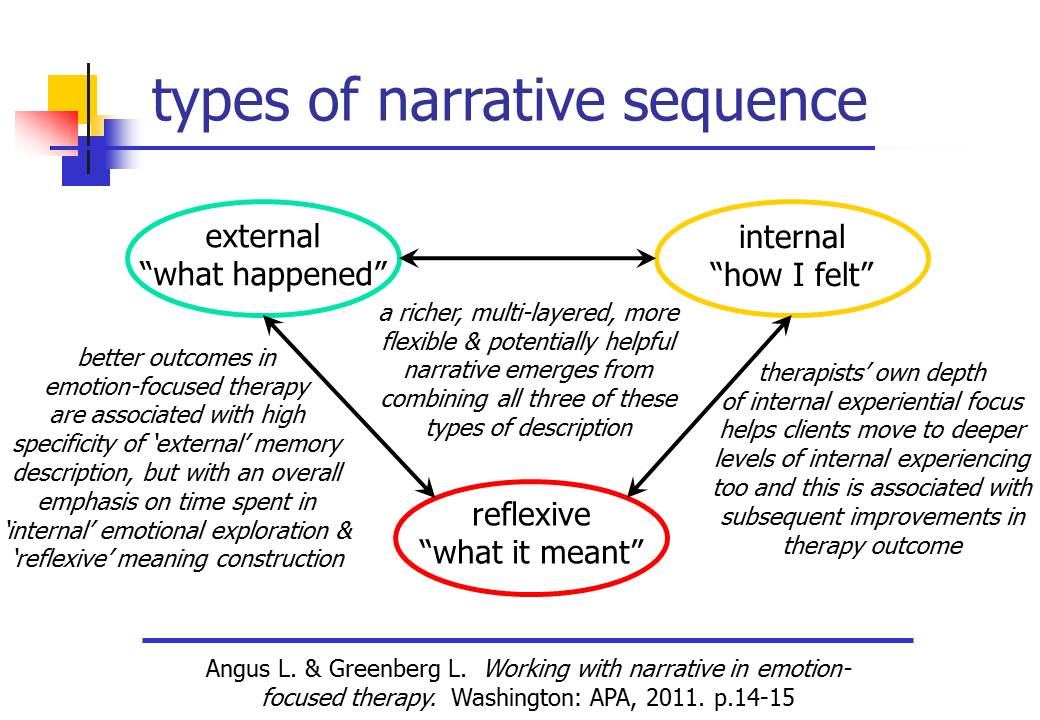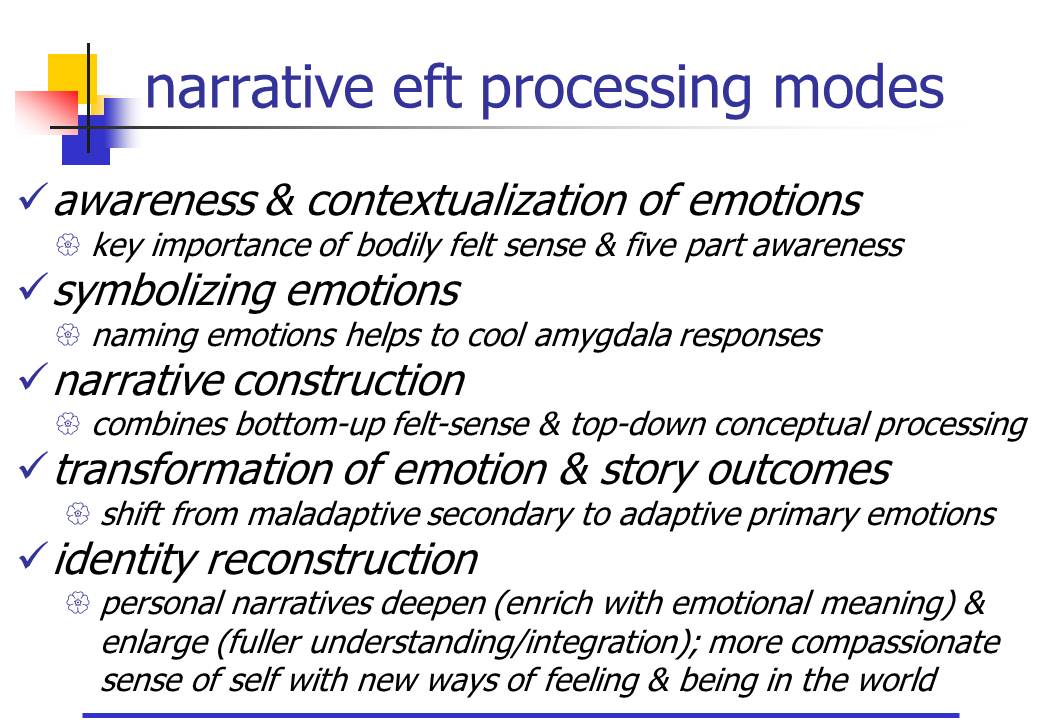Angus & Greenberg's book "Narrative in emotion-focused therapy" (2nd post): narrative types & modes
Last updated on 22nd August 2012
I wrote yesterday on "Angus & Greenberg's book "Narrative in emotion-focused therapy" (1st post): context". In today's post I would like to start scanning through the contents of Angus & Greenberg's 2011 book "Working with narrative in emotion-focused therapy: changing stories, healing lives". It's a short book, less than 150 pages of text. There are eight chapters - 1.) An introduction to working with narrative and emotion processes in EFT. 2.) How we make meaning: the dialectical-constructivist model. 3.) Facilitating narrative change processes in EFT. 4.) Problem markers: same old stories, empty stories, unstoried emotions, and broken stories. 5.) Meaning-making markers: untold stories, unique outcome stories, and healing stories. 6.) Working with narrative and emotion in depression: the case of Margaret. 6.) Working with narrative and emotion in trauma: the case of Alex. 8.) Conclusion.
In Chapter 1's introduction, Angus & Greenberg write "Narrative offers a space for self-reflection and self-construction, requiring us to interpret and make meaning of experience. As therapists, it is when we listen carefully to our clients' most important stories that we gain access to how people are attempting to make sense of themselves in the context of their social worlds. In this way, psychotherapy is a specialized discursive activity designed to help clients shape a desired future and reconstruct a more compassionate and sustaining narrative account of the past". They suggest "Types of narrative sequences include 'external' (describing past and current episodic memories, or 'what happened'), 'internal' (identifying emotional experiences, or 'how I felt'), and 'reflexive' (creating new meaning, or 'what it meant')" and they emphasise the importance of therapists helping clients shift more from 'external' to 'internal' and 'reflexive' descriptions. Apparently "the therapist's depth of experiential focus influences client's depth of experiencing, and this relates to outcome". In the chapter's concluding paragraphs they write "This approach involves retelling significant events, heightening client emotions, addressing limiting or incoherent narratives, and storying experiences of resilience. As with the original conceptualization of EFT, our narrative-informed EFT approach is guided by 'problem markers', or outward signs of a particular problem to address ... four common problem markers (are) same old stories, empty stories, unstoried emotions, and broken stories."

(This diagram is downloadable both as a Powerpoint slide and as a PDF file).
Chapter 2 - "How we make meaning: the dialectical-constructivist model" - begins "Rather than viewing the client as independently constructing meaning, a narrative-informed emotion-focused (EFT) perspective sees effective psychotherapy essentially as a coconstructive enterprise wherein the therapist is an important contributor to the meaning-making process." The first section of the chapter "presents a theory of how new meaning is made", while the second section provides "a clinical framework that draws on principles from the theory." As emphasised elsewhere in Les Greenberg's writings, it is suggested that "EFT therapists are most effective when they are able to both follow and guide their clients' experiencing during therapy sessions". And also, another familiar pattern from Les's many other books, there is a lego-building-instructions-list of numbered points to pay attention to - "The five overlapping - yet discernable - narrative and emotion-processing modes that support productive change in EFT are (a) awareness and contextualization of emotions, (b) symbolizing emotions, (c) narrative construction of emotional experience, (d) transformation of emotion and story outcomes, and (e) identity reconstruction." Mm ... ambitious and interesting. Each of these five "processing modes" is then discussed in more detail.

(This diagram is downloadable both as a Powerpoint slide and as a PDF file).
So for "(a) awareness and contextualization of emotions" it is underlined that "The first key processing strategy involves paying attention to the bodily felt sense that arises from a situational experience ... this complex felt sense needs to be attended to before it can be symbolized ... the felt sense is of the whole situation ... coded first as a wordless narrative in imagistic sensory and kinesthetic form, and it is to this we must attend to turn our lived story into a told story." In an earlier post - "Meeting at relational depth: a model" - I have given a diagram of Greenberg & Watson's "Five part emotional awareness" diagram with its inclusion of triggering circumstance, bodily reaction, impulse, wish or need, and verbal description. It is pointed out that "Awareness and acceptance of these emotions and the important meanings they convey about intentions, goals, and beliefs of self and others constitute the first step in awareness work." Then in "(b) symbolizing emotions" it is highlighted that "An important goal for EFT therapists, then, is to help clients symbolize in words the subjective emotional state they experienced in a particular situation, for further self-understanding." And it's also noted that "Undifferentiated states of high emotional arousal - or what we call "unstoried emotions" - are almost always experienced as disorganized, distressing, and frightening by clients." And as I wrote in the post "Naming emotions is another useful self-regulation & mindfulness strategy", putting feelings into words ("affect labeling") reduces the strengths of amygdala-based emotional responses.
For more on EFT & narrative therapy processing modes - see tomorrow's post.
(Both Powerpoint diagrams on this page can be downloaded together and then printed out as a two-slides-to-a-page handout).
